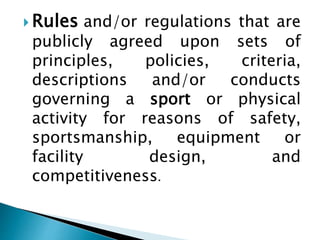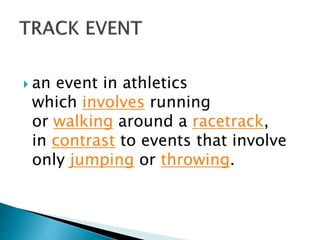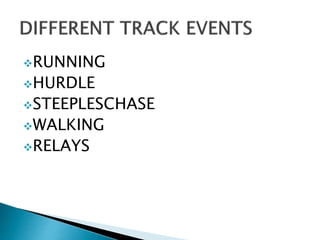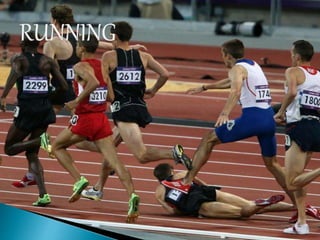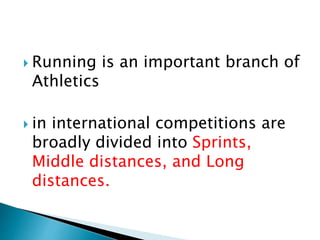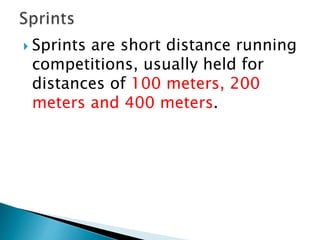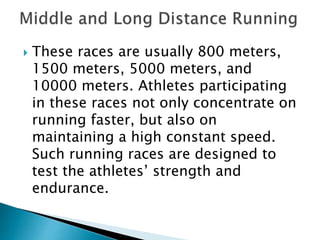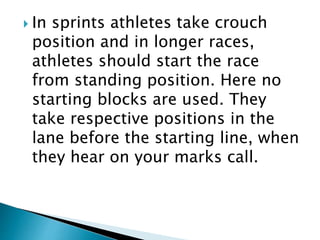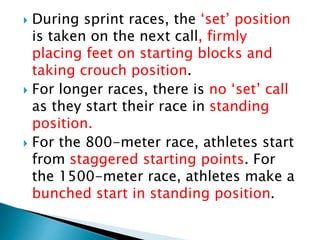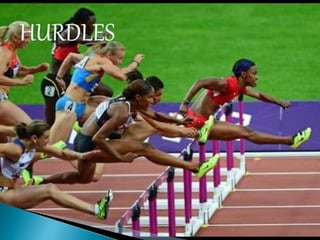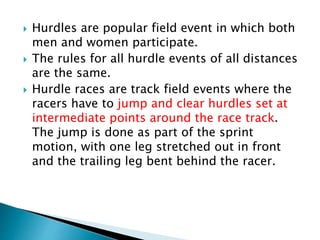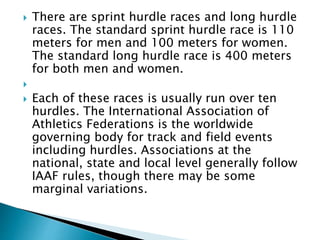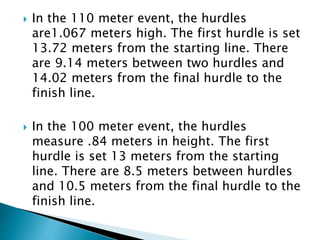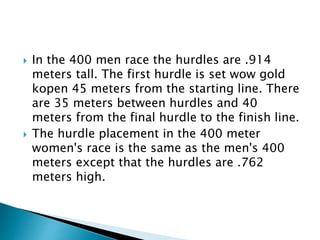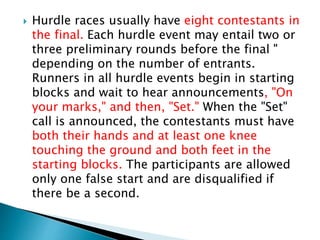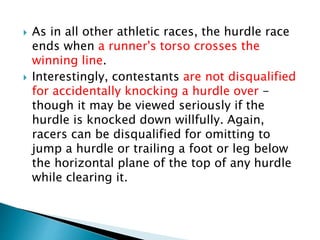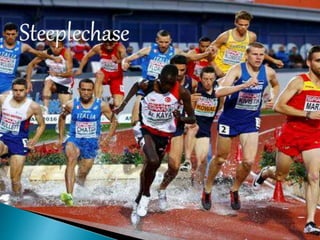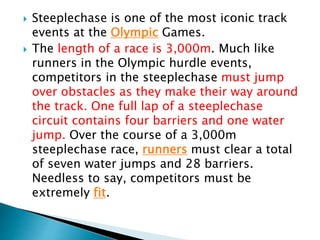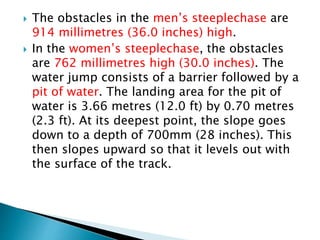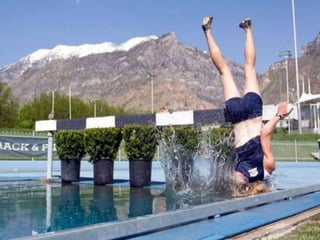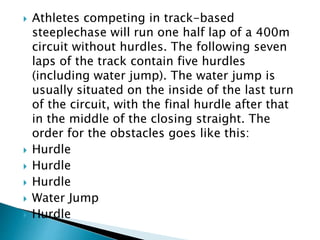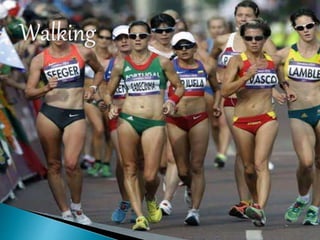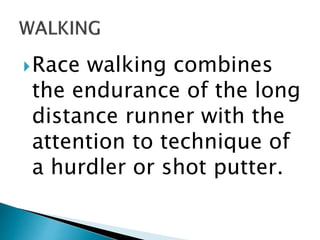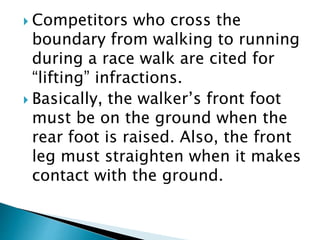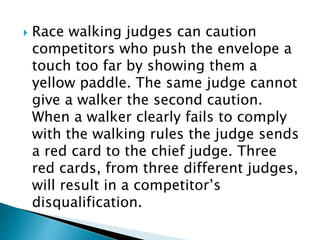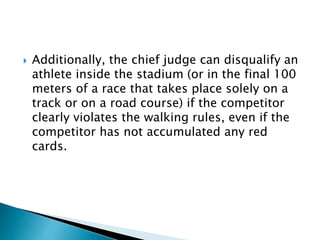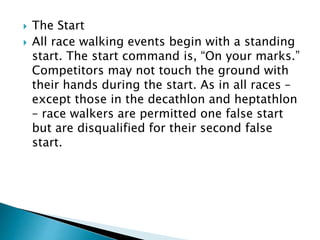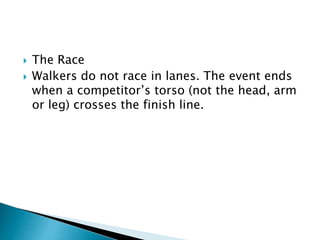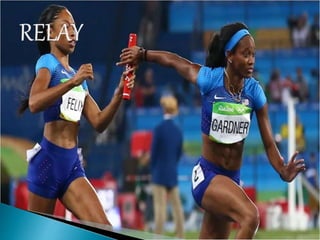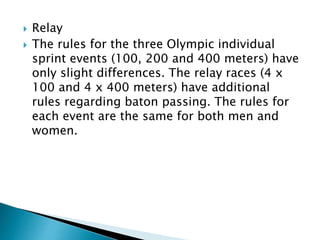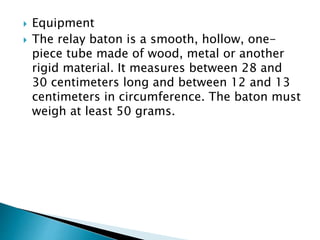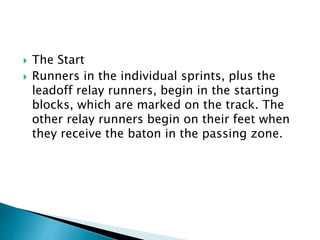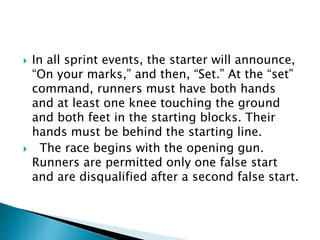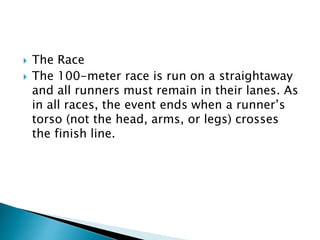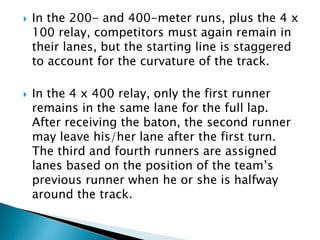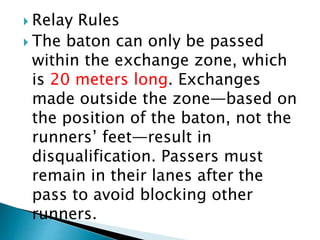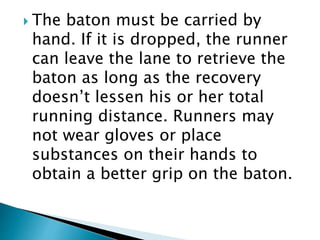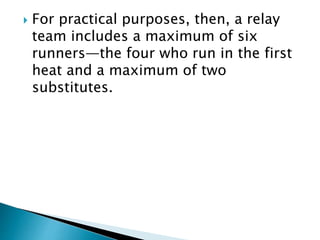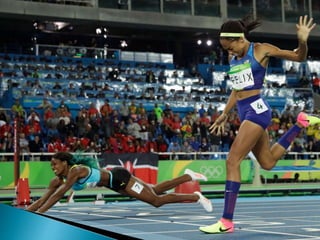Athletics Rules and Regulations
- 1. Cherry Anne Mendoza BS BIO-II
- 2. Rules and/or regulations that are publicly agreed upon sets of principles, policies, criteria, descriptions and/or conducts governing a sport or physical activity for reasons of safety, sportsmanship, equipment or facility design, and competitiveness.
- 3. an event in athletics which involves running or walking around a racetrack, in contrast to events that involve only jumping or throwing.
- 6. Running is an important branch of Athletics in international competitions are broadly divided into Sprints, Middle distances, and Long distances.
- 7. Sprints are short distance running competitions, usually held for distances of 100 meters, 200 meters and 400 meters.
- 8. These races are usually 800 meters, 1500 meters, 5000 meters, and 10000 meters. Athletes participating in these races not only concentrate on running faster, but also on maintaining a high constant speed. Such running races are designed to test the athletes’ strength and endurance.
- 9. In sprints athletes take crouch position and in longer races, athletes should start the race from standing position. Here no starting blocks are used. They take respective positions in the lane before the starting line, when they hear on your marks call.
- 10. During sprint races, the ‘set’ position is taken on the next call, firmly placing feet on starting blocks and taking crouch position. For longer races, there is no ‘set’ call as they start their race in standing position. For the 800-meter race, athletes start from staggered starting points. For the 1500-meter race, athletes make a bunched start in standing position.
- 12. Hurdles are popular field event in which both men and women participate. The rules for all hurdle events of all distances are the same. Hurdle races are track field events where the racers have to jump and clear hurdles set at intermediate points around the race track. The jump is done as part of the sprint motion, with one leg stretched out in front and the trailing leg bent behind the racer.
- 13. There are sprint hurdle races and long hurdle races. The standard sprint hurdle race is 110 meters for men and 100 meters for women. The standard long hurdle race is 400 meters for both men and women. Each of these races is usually run over ten hurdles. The International Association of Athletics Federations is the worldwide governing body for track and field events including hurdles. Associations at the national, state and local level generally follow IAAF rules, though there may be some marginal variations.
- 14. In the 110 meter event, the hurdles are1.067 meters high. The first hurdle is set 13.72 meters from the starting line. There are 9.14 meters between two hurdles and 14.02 meters from the final hurdle to the finish line. In the 100 meter event, the hurdles measure .84 meters in height. The first hurdle is set 13 meters from the starting line. There are 8.5 meters between hurdles and 10.5 meters from the final hurdle to the finish line.
- 15. In the 400 men race the hurdles are .914 meters tall. The first hurdle is set wow gold kopen 45 meters from the starting line. There are 35 meters between hurdles and 40 meters from the final hurdle to the finish line. The hurdle placement in the 400 meter women's race is the same as the men's 400 meters except that the hurdles are .762 meters high.
- 16. Hurdle races usually have eight contestants in the final. Each hurdle event may entail two or three preliminary rounds before the final " depending on the number of entrants. Runners in all hurdle events begin in starting blocks and wait to hear announcements, "On your marks," and then, "Set." When the "Set" call is announced, the contestants must have both their hands and at least one knee touching the ground and both feet in the starting blocks. The participants are allowed only one false start and are disqualified if there be a second.
- 17. As in all other athletic races, the hurdle race ends when a runner's torso crosses the winning line. Interestingly, contestants are not disqualified for accidentally knocking a hurdle over - though it may be viewed seriously if the hurdle is knocked down willfully. Again, racers can be disqualified for omitting to jump a hurdle or trailing a foot or leg below the horizontal plane of the top of any hurdle while clearing it.
- 19. Steeplechase is one of the most iconic track events at the Olympic Games. The length of a race is 3,000m. Much like runners in the Olympic hurdle events, competitors in the steeplechase must jump over obstacles as they make their way around the track. One full lap of a steeplechase circuit contains four barriers and one water jump. Over the course of a 3,000m steeplechase race, runners must clear a total of seven water jumps and 28 barriers. Needless to say, competitors must be extremely fit.
- 20. The obstacles in the men’s steeplechase are 914 millimetres (36.0 inches) high. In the women’s steeplechase, the obstacles are 762 millimetres high (30.0 inches). The water jump consists of a barrier followed by a pit of water. The landing area for the pit of water is 3.66 metres (12.0 ft) by 0.70 metres (2.3 ft). At its deepest point, the slope goes down to a depth of 700mm (28 inches). This then slopes upward so that it levels out with the surface of the track.
- 22. Athletes competing in track-based steeplechase will run one half lap of a 400m circuit without hurdles. The following seven laps of the track contain five hurdles (including water jump). The water jump is usually situated on the inside of the last turn of the circuit, with the final hurdle after that in the middle of the closing straight. The order for the obstacles goes like this: Hurdle Hurdle Hurdle Water Jump Hurdle
- 23. Unlike the hurdles used in track-based hurdling events, the steeplechase barriers do not fall over when hit by the athlete. The rules for steeplechase running allow the barriers to be traversed in any way the runner deems fit. Many runners, for example, will jump up on top of the barrier before stepping off and continuing their run. The slope in the water jump pit rewards runners with a greater jumping ability, because longer jumps result in the athlete landing in a shallower part of the water – saving valuable time in the process.
- 25. Race walking combines the endurance of the long distance runner with the attention to technique of a hurdler or shot putter.
- 26. Race walking differs from running in that it requires the competitor to maintain contact with the ground at all times and requires the leading leg to be straightened as the foot makes contact with the ground. It must remain straightened until the leg passes under the body. Judges evaluate the technique of race walkers and report fouls which may lead to disqualification. All judging is done by the eye of the judge and no outside technology is used in making judging decisions. In the Olympics, men compete in 20-kilometer and 50-kilometer race walking events while women participate in a 20-kilometer race walk.
- 27. Competitors who cross the boundary from walking to running during a race walk are cited for “lifting” infractions. Basically, the walker’s front foot must be on the ground when the rear foot is raised. Also, the front leg must straighten when it makes contact with the ground.
- 28. Race walking judges can caution competitors who push the envelope a touch too far by showing them a yellow paddle. The same judge cannot give a walker the second caution. When a walker clearly fails to comply with the walking rules the judge sends a red card to the chief judge. Three red cards, from three different judges, will result in a competitor’s disqualification.
- 29. Additionally, the chief judge can disqualify an athlete inside the stadium (or in the final 100 meters of a race that takes place solely on a track or on a road course) if the competitor clearly violates the walking rules, even if the competitor has not accumulated any red cards.
- 30. The Start All race walking events begin with a standing start. The start command is, “On your marks.” Competitors may not touch the ground with their hands during the start. As in all races – except those in the decathlon and heptathlon – race walkers are permitted one false start but are disqualified for their second false start.
- 31. The Race Walkers do not race in lanes. The event ends when a competitor’s torso (not the head, arm or leg) crosses the finish line.
- 33. Relay The rules for the three Olympic individual sprint events (100, 200 and 400 meters) have only slight differences. The relay races (4 x 100 and 4 x 400 meters) have additional rules regarding baton passing. The rules for each event are the same for both men and women.
- 34. Equipment The relay baton is a smooth, hollow, one- piece tube made of wood, metal or another rigid material. It measures between 28 and 30 centimeters long and between 12 and 13 centimeters in circumference. The baton must weigh at least 50 grams.
- 35. The Start Runners in the individual sprints, plus the leadoff relay runners, begin in the starting blocks, which are marked on the track. The other relay runners begin on their feet when they receive the baton in the passing zone.
- 36. In all sprint events, the starter will announce, “On your marks,” and then, “Set.” At the “set” command, runners must have both hands and at least one knee touching the ground and both feet in the starting blocks. Their hands must be behind the starting line. The race begins with the opening gun. Runners are permitted only one false start and are disqualified after a second false start.
- 37. The Race The 100-meter race is run on a straightaway and all runners must remain in their lanes. As in all races, the event ends when a runner’s torso (not the head, arms, or legs) crosses the finish line.
- 38. In the 200- and 400-meter runs, plus the 4 x 100 relay, competitors must again remain in their lanes, but the starting line is staggered to account for the curvature of the track. In the 4 x 400 relay, only the first runner remains in the same lane for the full lap. After receiving the baton, the second runner may leave his/her lane after the first turn. The third and fourth runners are assigned lanes based on the position of the team’s previous runner when he or she is halfway around the track.
- 39. Relay Rules The baton can only be passed within the exchange zone, which is 20 meters long. Exchanges made outside the zone—based on the position of the baton, not the runners’ feet—result in disqualification. Passers must remain in their lanes after the pass to avoid blocking other runners.
- 40. The baton must be carried by hand. If it is dropped, the runner can leave the lane to retrieve the baton as long as the recovery doesn’t lessen his or her total running distance. Runners may not wear gloves or place substances on their hands to obtain a better grip on the baton.
- 41. For practical purposes, then, a relay team includes a maximum of six runners—the four who run in the first heat and a maximum of two substitutes.


